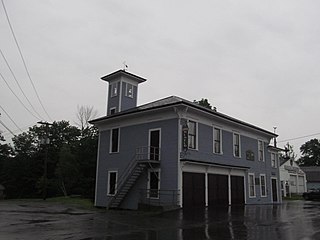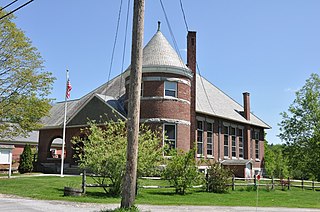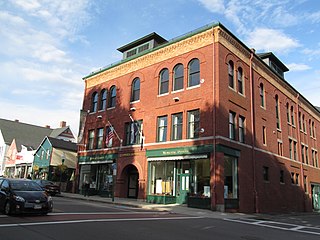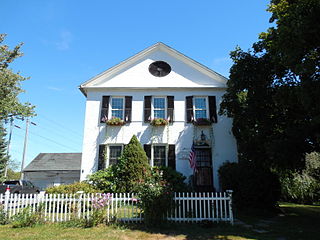
The Ogle County Courthouse is a National Register of Historic Places listing in the Ogle County, Illinois, county seat of Oregon. The building stands on a public square in the city's downtown commercial district. The current structure was completed in 1891 and was preceded by two other buildings, one of which was destroyed by a group of outlaws. Following the destruction of the courthouse, the county was without a judicial building for a period during the 1840s. The Ogle County Courthouse was designed by Chicago architect George O. Garnsey in the Romanesque Revival style of architecture. The ridged roof is dominated by its wooden cupola which stands out at a distance.

Windsor Locks station is an Amtrak and CT Rail train station in Windsor Locks, Connecticut, on the New Haven–Springfield Line. It is served by four Amtrak services - the Hartford Line shuttles, Northeast Regional, Valley Flyer, and Vermonter - as well as CT Rail Hartford Line commuter rail trains.

The Deacon John Moore House is a historic house at 37 Elm Street in Windsor, Connecticut. The oldest portion of the house was built in 1664, making it one of the oldest houses in the state. It has been altered and renovated, but retains its original frame and other elements. It was listed on the National Register of Historic Places in 1977.

Ware Town Hall is a historic town hall at Main and West Streets in Ware, Massachusetts. It was built in 1885 to a design by the architectural firm of Hartwell and Richardson, and is a prominent local example of Romanesque Revival architecture. The building, enlarged in 1904 and 1935 with stylistically sensitive additions, was listed on the National Register of Historic Places in 1986.

The Academy Historic District is a historic district in the center of Wilbraham, Massachusetts. Its 65 acres (26 ha) encompass the historic center of Wilbraham, as well as the historic central portion of the campus of the Wilbraham & Monson Academy. It includes properties on Mountain Road, Main Street, and Faculty Street. Wesleyan Academy was founded in 1817 and moved to Wilbraham in 1824; its oldest buildings date to 1825. It merged with Monson Academy in the 20th century to form the present school that occupies the academic premises. The academy was a major center of Methodist teaching in New England, and was a prominent factor in the town's growth.

Memorial Town Hall is the historic town hall of Monson, Massachusetts. Located on Main Street on land donated by the local prominent Reynolds family, the High Victorian Gothic stone building was constructed in 1885 to a design by George Potter. In keeping with a memorial to the town's fallen soldiers, there are two cannons in front of the building.

Palmer Memorial Hall is a historic hall at 1029 Central Street in Palmer, Massachusetts. The Romanesque building was designed by New York City architect R. H. Robertson and constructed in 1890 as a memorial to the town's Civil War dead; it was also used as a meeting space by the local Grand Army of the Republic veterans society. The ground floor served as the town's public library until 1977. It has since served as Palmer's Senior Center. The building was listed on the National Register of Historic Places in 1999.

The G.A.R. Hall and Museum is a historic museum at 58 Andrew Street in Lynn, Massachusetts.

Knowlton Memorial Hall, also known as Ashford Town Hall, is located at 5 Town Hall Road in Ashford, Connecticut. It was built in 1924 to house town offices and the public library. Construction was made possible by a gift from Charles Knowlton, whose family had lived in the area since the 18th century. When built, it featured a number of modern innovations, including electrical service, and steam heat. In addition to town offices and the library, the building also has an auditorium which is used for town meetings. The building was listed on the National Register of Historic Places in 1994.

Stephen Carpenter Earle was an architect who designed a number of buildings in Massachusetts and Connecticut that were built in the late 19th century, with many in Worcester, Massachusetts. He trained in the office of Calvert Vaux in New York City. He worked for a time in partnership with James E. Fuller, under the firm "Earle & Fuller". In 1891, he formed a partnership with Vermont architect Clellan W. Fisher under the name "Earle & Fisher".

The Monson Historical Society Museum is located on Main Street in the center of Monson, Maine. It is housed in a former municipal building, built in 1889 to house firefighting equipment and a fraternal lodge, and listed on the National Register of Historic Places as Monson Engine House (Former) on August 5, 2005, as one of a small number of surviving 19th-century fire stations in rural interior Maine. The museum is open on Saturdays in the summer, showing items of local historical interest.

The Thomaston Opera House is a historic performance venue and the town hall of Thomaston, Connecticut. Located at 153 Main Street, it was built in 1883-85, and is a good local example of Romanesque architecture. The theater in the building has served as a performance and film venue since its construction. It was listed on the National Register of Historic Places in 1972. The opera house's principal tenant is now the Landmark Community Theatre.

Pillsbury Memorial Hall, located at 93 Main Street, is the town hall of Sutton, New Hampshire. It was built in 1891, funded by a gift from New Hampshire native John Sargent Pillsbury, founder of the Pillsbury Company and a leading Minnesota politician. It is the only Romanesque style town hall building in Merrimack County. The building was listed on the National Register of Historic Places in 1993.

Brewster Memorial Hall is the town hall of Wolfeboro, New Hampshire. It is located at the junction of South Main Street and Union Street in the town center. Its construction in 1880-90 was the result of a bequest from Wolfeboro native John W. Brewster, with terms stipulating that the building should resemble Sargent Hall in Merrimac, Massachusetts. It was listed on the National Register of Historic Places in 1983.

The Weare Town House is a historic New England meeting house on New Hampshire Route 114 in Weare, New Hampshire. Built in 1837, it is a good example of a period town hall/church combination with Federal and Gothic Revival features. Although its religious use has ended, it continues to be used for town offices as well as civic and social functions. The building was listed on the National Register of Historic Places in 1985.

Stevens Memorial Hall is the historic town hall of Chester, New Hampshire. The building, a large wood-frame structure completed in 1910, is located in the center of Chester at the junction of New Hampshire Routes 121 and 102. The building was listed on the National Register of Historic Places in 2004. It served as the center of the town's civic business until 2000, when town offices were relocated to a former school.

The Camden Opera House Block is a historic multifunction building at 29 Elm Street in the center of Camden, Maine, United States. Built in 1893 after the town's great 1892 fire, it is one of its most prominent buildings. It houses town offices, a social meeting hall, and a 500-seat theater. The building was listed on the National Register of Historic Places in 1986.

The Soldiers and Sailors Memorial Building in West Newbury, Massachusetts is a historic American Civil War memorial building at 363 Main Street. Built in 1900, it is a distinctive local example of Gothic Revival architecture. It has served as a meeting place for veterans organizations and housed the local public library for 12 years. It was listed on the National Register of Historic Places in 2016.

The Elijah Mills House is a United States historic house at 45 Deerfield Road in Windsor, Connecticut. Built in 1822, it is a well-preserved local example of a Federal period brick house. It was listed on the National Register of Historic Places in 1985.

The Oliver W. Mills House is a historic house at 148 Deerfield Road in Windsor, Connecticut. Built in 1824, it is a well-preserved local example of a Federal period brick house. It was listed on the National Register of Historic Places in 1985.






















